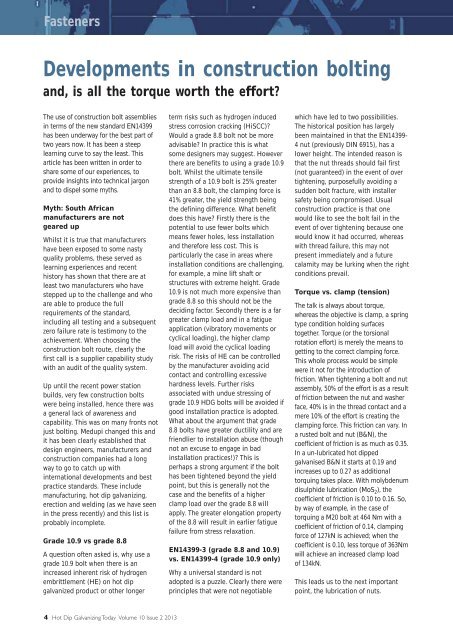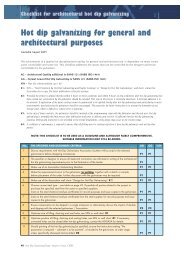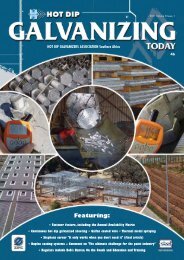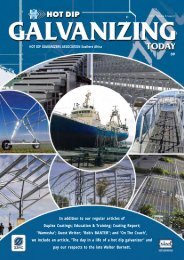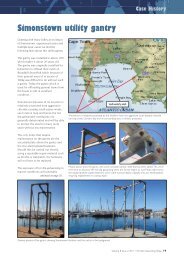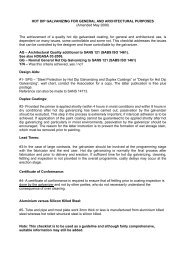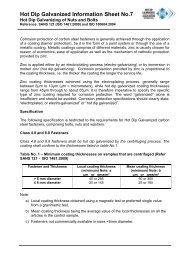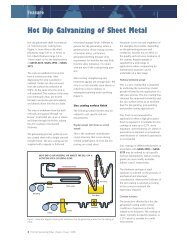Fasteners - hdgasa
Fasteners - hdgasa
Fasteners - hdgasa
Create successful ePaper yourself
Turn your PDF publications into a flip-book with our unique Google optimized e-Paper software.
<strong>Fasteners</strong><br />
Developments in construction bolting<br />
and, is all the torque worth the effort?<br />
The use of construction bolt assemblies<br />
in terms of the new standard EN14399<br />
has been underway for the best part of<br />
two years now. It has been a steep<br />
learning curve to say the least. This<br />
article has been written in order to<br />
share some of our experiences, to<br />
provide insights into technical jargon<br />
and to dispel some myths.<br />
Myth: South African<br />
manufacturers are not<br />
geared up<br />
Whilst it is true that manufacturers<br />
have been exposed to some nasty<br />
quality problems, these served as<br />
learning experiences and recent<br />
history has shown that there are at<br />
least two manufacturers who have<br />
stepped up to the challenge and who<br />
are able to produce the full<br />
requirements of the standard,<br />
including all testing and a subsequent<br />
zero failure rate is testimony to the<br />
achievement. When choosing the<br />
construction bolt route, clearly the<br />
first call is a supplier capability study<br />
with an audit of the quality system.<br />
Up until the recent power station<br />
builds, very few construction bolts<br />
were being installed, hence there was<br />
a general lack of awareness and<br />
capability. This was on many fronts not<br />
just bolting. Medupi changed this and<br />
it has been clearly established that<br />
design engineers, manufacturers and<br />
construction companies had a long<br />
way to go to catch up with<br />
international developments and best<br />
practice standards. These include<br />
manufacturing, hot dip galvanizing,<br />
erection and welding (as we have seen<br />
in the press recently) and this list is<br />
probably incomplete.<br />
Grade 10.9 vs grade 8.8<br />
A question often asked is, why use a<br />
grade 10.9 bolt when there is an<br />
increased inherent risk of hydrogen<br />
embrittlement (HE) on hot dip<br />
galvanized product or other longer<br />
term risks such as hydrogen induced<br />
stress corrosion cracking (HiSCC)?<br />
Would a grade 8.8 bolt not be more<br />
advisable? In practice this is what<br />
some designers may suggest. However<br />
there are benefits to using a grade 10.9<br />
bolt. Whilst the ultimate tensile<br />
strength of a 10.9 bolt is 25% greater<br />
than an 8.8 bolt, the clamping force is<br />
41% greater, the yield strength being<br />
the defining difference. What benefit<br />
does this have? Firstly there is the<br />
potential to use fewer bolts which<br />
means fewer holes, less installation<br />
and therefore less cost. This is<br />
particularly the case in areas where<br />
installation conditions are challenging,<br />
for example, a mine lift shaft or<br />
structures with extreme height. Grade<br />
10.9 is not much more expensive than<br />
grade 8.8 so this should not be the<br />
deciding factor. Secondly there is a far<br />
greater clamp load and in a fatigue<br />
application (vibratory movements or<br />
cyclical loading), the higher clamp<br />
load will avoid the cyclical loading<br />
risk. The risks of HE can be controlled<br />
by the manufacturer avoiding acid<br />
contact and controlling excessive<br />
hardness levels. Further risks<br />
associated with undue stressing of<br />
grade 10.9 HDG bolts will be avoided if<br />
good installation practice is adopted.<br />
What about the argument that grade<br />
8.8 bolts have greater ductility and are<br />
friendlier to installation abuse (though<br />
not an excuse to engage in bad<br />
installation practices!)? This is<br />
perhaps a strong argument if the bolt<br />
has been tightened beyond the yield<br />
point, but this is generally not the<br />
case and the benefits of a higher<br />
clamp load over the grade 8.8 will<br />
apply. The greater elongation property<br />
of the 8.8 will result in earlier fatigue<br />
failure from stress relaxation.<br />
EN14399-3 (grade 8.8 and 10.9)<br />
vs. EN14399-4 (grade 10.9 only)<br />
Why a universal standard is not<br />
adopted is a puzzle. Clearly there were<br />
principles that were not negotiable<br />
which have led to two possibilities.<br />
The historical position has largely<br />
been maintained in that the EN14399-<br />
4 nut (previously DIN 6915), has a<br />
lower height. The intended reason is<br />
that the nut threads should fail first<br />
(not guaranteed) in the event of over<br />
tightening, purposefully avoiding a<br />
sudden bolt fracture, with installer<br />
safety being compromised. Usual<br />
construction practice is that one<br />
would like to see the bolt fail in the<br />
event of over tightening because one<br />
would know it had occurred, whereas<br />
with thread failure, this may not<br />
present immediately and a future<br />
calamity may be lurking when the right<br />
conditions prevail.<br />
Torque vs. clamp (tension)<br />
The talk is always about torque,<br />
whereas the objective is clamp, a spring<br />
type condition holding surfaces<br />
together. Torque (or the torsional<br />
rotation effort) is merely the means to<br />
getting to the correct clamping force.<br />
This whole process would be simple<br />
were it not for the introduction of<br />
friction. When tightening a bolt and nut<br />
assembly, 50% of the effort is as a result<br />
of friction between the nut and washer<br />
face, 40% is in the thread contact and a<br />
mere 10% of the effort is creating the<br />
clamping force. This friction can vary. In<br />
a rusted bolt and nut (B&N), the<br />
coefficient of friction is as much as 0.35.<br />
In a un-lubricated hot dipped<br />
galvanised B&N it starts at 0.19 and<br />
increases up to 0.27 as additional<br />
torquing takes place. With molybdenum<br />
disulphide lubrication (MoS 2 ), the<br />
coefficient of friction is 0.10 to 0.16. So,<br />
by way of example, in the case of<br />
torquing a M20 bolt at 464 Nm with a<br />
coefficient of friction of 0.14, clamping<br />
force of 127kN is achieved; when the<br />
coefficient is 0.10, less torque of 363Nm<br />
will achieve an increased clamp load<br />
of 134kN.<br />
This leads us to the next important<br />
point, the lubrication of nuts.<br />
4 Hot Dip Galvanizing Today Volume 10 Issue 2 2013


